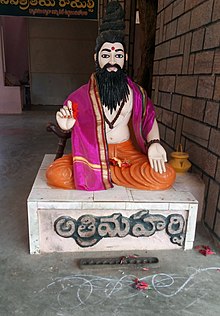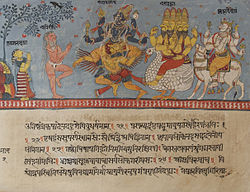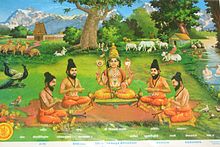Atri
| Atri | |
|---|---|
 | |
| Affiliation | Brahmarshi |
| Genealogy | |
| Parents |
|
| Spouse | Anasuya |
| Children | Durvasa, Chandra and Dattatreya |
Atri or Attri is a Vedic sage, who is credited with composing numerous hymns to Agni, Indra, and other Vedic deities of Hinduism. Atri is one of the Saptarishi (seven great Vedic sages) in the Hindu tradition, and the one most mentioned in its scripture Rigveda.[1]
The fifth Mandala (Book 5) of the Rigveda is called the Atri Mandala in his honour, and the eighty seven hymns in it are attributed to him and his descendants.[2]
Atri is also mentioned in the Puranas and the Hindu epics of the Ramayana and the Mahabharata.[3][4]
Legend
[edit]
Atri is one of the seven great Rishis or Saptarshi along with Marichi, Angiras, Pulaha, Kratu, Pulastya and Vashistha.[1] According to the legends of the Vedic era, sage Atri was married to Anasuya Devi. They had three sons, Dattatreya, Durvasa and Chandra.[5] As per divine account, he is the last among the seven Saptarishis and is believed to have originated from the tongue. The wife of Atri was Anasuya, who is considered one of the seven female pativratas. When instructed by divine voice to do tapas, Atri readily agreed and did severe tapas. Pleased by his devotion and prayers, the Hindu trinity, namely, Brahma, Vishnu, and Shiva appeared before him and offered him boons. He sought all the three to be born to him. Another version of the legend states that Anasuya, by the powers of her chastity, rescued the three gods and in return, they were born as children to her. Brahma was born to her as Chandra, Vishnu as Dattatreya and Shiva in some part as Durvasa. The mention of Atri is found in various scriptures, with the notable being in Rig Veda. He is also associated with various ages, the notable being in Treta Yuga during Ramayana, when he and Anasuya advised Rama and his wife Sita. The pair is also attributed to bringing river Ganga down to earth, the mention of which is found in the Shiva Purana.[6]
He is said to be a resident of the south in Valmiki Ramayana.[7] The same is supported by Puranic tradition.
Seer of Rig Veda
[edit]
He is the seer of the fifth Mandala (Book 5) of the Rigveda. Atri had many sons and disciples who have also contributed in the compilation of the Rig Veda and other Vedic texts. Mandala 5 comprises 87 hymns, mainly to Agni and Indra, but also to the Visvedevas ("all the gods'), the Maruts, the twin-deity Mitra-Varuna and the Asvins.[8] Two hymns each are dedicated to Ushas (the dawn) and to Savitr. Most hymns in this book are attributed to the Atri clan composers, called the Atreyas.[4]
The Atri hymns of the Rigveda are significant for their melodic structure as well as for featuring spiritual ideas in the form of riddles. These hymns include lexical, syntactic, morphological and verb play utilizing the flexibility of the Sanskrit language.[9] The hymn 5.44 of the Rigveda in Atri Mandala is considered by scholars such as Geldner to be the most difficult riddle hymn in all of the Rigveda.[10] The verses are also known for their elegant presentation of natural phenomenon through divinely inspired poems, such as poetically presenting dawn as a cheerful woman in hymn 5.80.[9]
While the fifth mandala is attributed to Atri and his associates, sage Atri is mentioned or credited with numerous other verses of the Rigveda in other Mandalas, such as 10.137.4.[11]
Ramayana
[edit]In the Ramayana, Rama, Sita and Lakshmana visit Atri and Anasuya in their hermitage. Atri's hut is described to be in Chitrakuta,[4] near a lake with divine music and songs, the water loaded with flowers, green water leaves, with many "cranes, fisherbirds, floating tortoises, swans, frogs and pink geese".[3]
Puranas
[edit]A number of sages named Atri are mentioned in the various medieval era Puranas. The legends therein about Atri are diverse and inconsistent. It is unclear if these refer to the same person, or to different Rishis who had the same name.[4]
Cultural influence
[edit]
The Vaikhanasas sub-tradition within Vaishnavism found in South India near Tirupati, credit their theology to four Rishis (sages), namely Atri, Marichi, Bhrigu and Kashyapa. One of the ancient texts of this tradition is Atri Samhita, which survives in highly inconsistent fragments of manuscripts.[12] The text are rules of conduct aimed at Brahmins of the Vaikhanasas tradition.[13] The surviving parts of the Atri Samhita suggest that the text discussed, among other things, yoga, and ethics of living, with precepts such as:
Self restraint:
- If material or spiritual pain is created by others, and one is not offended and does not wreak revenge, it is called Dama.
Charity:
- Even with limited income, something should be given away daily with care and liberal spirit. This is called Dana.
Compassion:
- One should behave like his own self, towards others, his own relations and friends, him who envies him, and even his enemy. This is called Daya.
— Atri Samhita, Translated by MN Dutt[14]
The Vaikhanasas continue to be a significant community in South India, and they adhere to their Vedic heritage.[15]
See also
[edit]References
[edit]- ^ a b Antonio Rigopoulos (1998). Dattatreya: The Immortal Guru, Yogin, and Avatara. State University of New York Press. pp. 2–4. ISBN 978-0-7914-3696-7.
- ^ Stephanie W. Jamison; Joel P. Brereton (2014). The Rigveda. Oxford University Press. pp. 659–660. ISBN 978-0-19-937018-4.
- ^ a b Alf Hiltebeitel (2016). Nonviolence in the Mahabharata: Siva’s Summa on Rishidharma and the Gleaners of Kurukshetra. Routledge. pp. 55–56, 129. ISBN 978-1-317-23877-5.
- ^ a b c d Roshen Dalal (2010). Hinduism: An Alphabetical Guide. Penguin Books. p. 49. ISBN 978-0-14-341421-6.
- ^ Antonio Rigopoulos (1998). Dattatreya: The Immortal Guru, Yogin, and Avatara. State University of New York Press. pp. 1–3. ISBN 978-0-7914-3696-7.
- ^ Sathyamayananda, Swami. Ancient sages. Mylapore, Chennai: Sri Ramakrishna Math. pp. 17–20. ISBN 81-7505-356-9.
- ^ Ramayana, Valmiki (1952). Ramayana of Valmiki. India: Hari Prasad Shastri. pp. Book 7, chapter 1. ISBN 9789333119597.
- ^ Stephanie W. Jamison; Joel P. Brereton (2014). The Rigveda. Oxford University Press. pp. 659–771. ISBN 978-0-19-937018-4.
- ^ a b Stephanie W. Jamison; Joel P. Brereton (2014). The Rigveda. Oxford University Press. p. 660. ISBN 978-0-19-937018-4.
- ^ Stephanie W. Jamison; Joel P. Brereton (2014). The Rigveda. Oxford University Press. pp. 660, 714–715. ISBN 978-0-19-937018-4.
- ^ Stephanie W. Jamison; Joel P. Brereton (2014). The Rigveda. Oxford University Press. pp. 1622–1623. ISBN 978-0-19-937018-4.
- ^ Jan Gonda (1969). Aspects of Early Viṣṇuism. Motilal Banarsidass. pp. 241–242 with footnote 30. ISBN 978-81-208-1087-7.
- ^ Atri (Mahaṛiṣi.); V. Raghunathachakravarti Bhattacharya; Mānavalli Rāmakr̥ṣṇakavi (1943). Samurtarchanadhikarana (Atri-samhita). Tirumalai-Tirupati Devasthanams Press.
- ^ Manmatha Nath Dutt (1908). Yâjnawalkya Samhitâ. Hârita Samhitâ. Us'ana Samhitâ. Angiras Samhitâ. Yama Samhitâ. Atri Samhitâ. Samvarta Samhitâ. Kâtyayana Samhitâ. Vrihaspati Samhitâ. Daksha Samhitâ. Sâtâtapa Samhitâ. Likhita Samhitâ. Vyâsa Samhitâ. Elysium Press. p. 291.
- ^ J. Gonda (1977), Religious Thought and Practice in Vaikhānasa Viṣṇuism, Bulletin of the School of Oriental and African Studies, Cambridge University Press, Volume 40, Number 3, pages 550-571
Sources
[edit]- Anthony, David W. (2007), The Horse The Wheel And Language. How Bronze-Age Riders From the Eurasian Steppes Shaped The Modern World, Princeton University Press
- Flood, Gavin D. (1996), An Introduction to Hinduism, Cambridge University Press
- Kambhampati, Parvathi Kumar (2000). Sri Dattatreya (First ed.). Visakhapatnam: Dhanishta.
- Rigopoulos, Antonio (1998). Dattatreya: The Immortal Guru, Yogin, and Avatara. New York: State University of New York Press. ISBN 0-7914-3696-9
- Witzel, Michael (1995), "Early Sanskritization: Origin and Development of the Kuru state" (PDF), EJVS, 1 (4), archived from the original (PDF) on 20 February 2012


